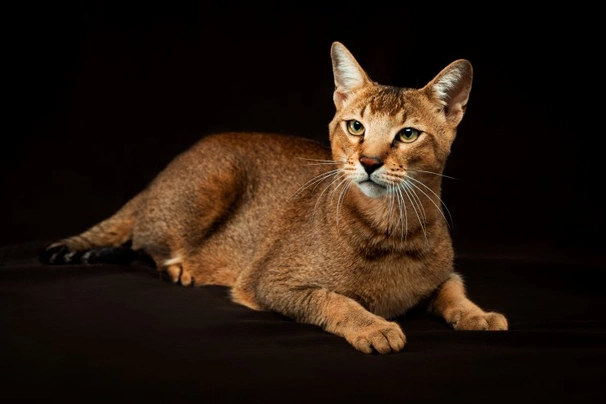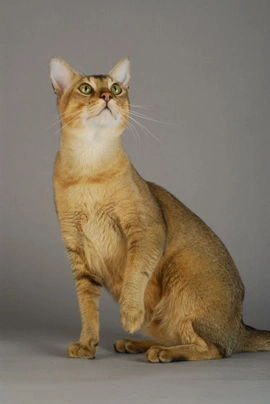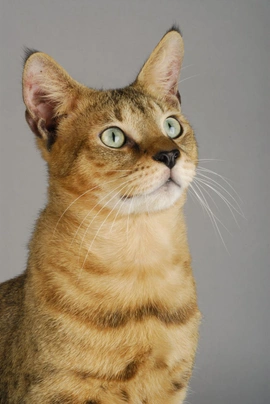Chausie
Introduction of the Chausie
The Chausie was first created in 1990 by crossing a Jungle Cat with a domestic cat after which time breeders concentrated on producing a "wild" looking cat that boasted a kind placid and affectionate nature. The breed was awarded full Championship status by TICA in 2013 but has yet to be recognised by the Governing Council of the Cat Fancy (GCCF). The breed's name "Chausie" is derived from the Latin name for the Jungle Cat which is felis chaus and since these large handsome cats first appeared on the scene they have found a fan base in many countries of the world including in the UK.
History of the Chausie
The Chausie was first bred in France by crossing a Jungle Cat with a domestic cat. The breeder's end goal was to create a kind affectionate domesticated cat that boasted having the traits and physical characteristics of a Jungle Cat. Breeders succeeded in producing large handsome cats that boasted kind and placid natures and since the breed first appeared on the scene breeders in other countries of the world have started producing healthy examples of the Chausie.
The Jungle Cat is native to the Nile Valley but is also found in other parts of the world which includes South Asia. These cats were revered by the Ancient Egyptians and mummified remains of Jungle Cats have been discovered in Pharaoh’s tombs having been buried with their owners so they could accompany them into the "afterlife".
It is thought that Jungle Cats often mated with domestic cats and over the centuries hybrid cats have been reported in many countries of the world including North America Southeast Asia and India but it was only in the nineties that European breeders began a breeding programme to produce healthy handsome and large cats by crossing Jungle Cats with domestic cats. TICA awarded the Chausie full Championship status in 2015 but for the moment (December 2016) the breed is not recognised by the GCCF.
Appearance of the Chausie
The Chausie was bred to keep the physical characteristics of a Jungle Cat. They are medium to large in size with long legs and bodies. Their heads are a modified wedge shape and when seen from the front they have a nice width with lovely high long cheekbones. They have long muzzles which adds balance to their cheekbones. Their muzzles are nicely contoured with cats having full chins and puffy nose leathers which adds to their wild appearance.
Chausies have small to medium sized eyes with the bottom half being oval and which slant to the outer base of a cat's ears. The top part of the eye is a lot flatter but still a nice half oval shape. Eye colour can be gold or yellow with some cats having light green or hazel eyes. When seen in profile a Chausie has a sloping forehead and their noses rise towards the tip which forms a slight bump just above a cat's nose leather. They have large upright tall ears that are set at a slight angle on the top of a cat's head. Their ears are quite wide from the base to the tip and Chausies have tufts on the tips of their ears although some cats do not.
The Chausie has a moderately long and thick neck which adds to their graceful appearance. They have long lean bodies and deep chests. Their legs are long showing a moderate amount of bone and their feet are medium in size and oval-shaped. Tails are quite short and moderately wide tapering slightly to the tip.
When it comes to their coat the Chausie boasts having a short to medium length coat with the length being long enough so that two bands of ticking appear in their coats. Their coats are dense having a soft undercoats and slightly harsher topcoat. Black coated cats often have softer coats to the touch whereas black grizzled coated cats often have coarser coats. Chausies come in a variety of colours which are as follows:
- Brown Ticked Tabby - a cat’s coat is mouse grey nearer the skin with a sandy grey or reddish gold base colour. Cats have two or three bands of darker ticking in their coats and tails upper inside of the legs and hocks on back legs are nicely barred. Their necks can have necklaces or not and there should be a thumbprint on each of a cat's ears that are lighter in colour. Eyes and muzzles are nicely outlined with an off-white colour. Their underbellies can be off white to sandy gold with a little flecking or speckling being allowed on their bellies.
- Black - cats have a solid black coat
- Black Grizzled Ticked Tabby - cats have a pattern in their coat that closely resembles that of a Jungle Cat. Each shaft of hair is banded with a lighter colour and end in a darker tip
Temperament of the Chausie
Like other breeds the Chausie likes a routine and doesn't particularly like it when this changes for any reason. They like to be fed at the same time of the day and don't appreciate it when furniture gets moved around the home which can often stress cats out. With this said Chausies are quite laid back by nature although they are energetic and like to be kept busy when they are not snoozing that is. They thrive on human company and don't like being left on their own for any length of time. As such these active intelligent cats are best suited to families where at least one person stays at home when everyone else is out of the house.
They are known to be good natured and affectionate cats that love interacting with their owners and are particularly fond of playing games like fetch which they are very skilled at. They form extremely strong bonds with their owners and can be taught to wear a harness and be taken for a walk on a lead much like their canine counterparts. Chausies remain very playful right through their lives which is just one of the reasons they are such a pleasure to share a home with.
Intelligence / Trainability of the Chausie
The Chausie is a highly intelligent cat and one that needs to be given a ton of stimulation to keep them happy. Because they are valuable cats that like to roam most owners opt to keep them as indoor pets and providing a Chausie has the right amount of company and things to keep them busy they adapt well to being kept as indoor cats. They learn new things very quickly and can be taught to wear a harness and walk on a lead just like their canine counterparts. Chausies thoroughly enjoy going out for a stroll with their owners especially if they are kept as indoor pets because it allows them to explore their surroundings while at the same time being kept safe.
Children and other
Chausies with their outgoing affectionate personalities are a good choice for families with children. They are quick on their feet and therefore know when to get out of the reach of smaller children when they get too boisterous or loud. However care should be taken when very young children are around cats and any interaction should always be well supervised by an adult to make sure things stay nice and calm. With this said younger children need to be taught how to behave around cats and when it's time to leave them alone.
They also get on well with dogs especially if they have grown up together in the same household. Chausies being so gregarious enjoy the company of other animals and much prefer being around them than being left on their own. However care should be taken when introducing a Chausie to dogs they don't already know just in case the dog does not get on with their feline counterparts. They are social by nature and have been known to get on with large pet birds and some small animals but it's always wiser to keep a close eye on any cat when they are around smaller pets particularly when they first meet each other.
Health of the Chausie
The average life expectancy of a Chausie is between 12 and 14 years when properly cared for and fed an appropriate good quality diet to suit their ages.
The Chausie is known to be a healthy breed and one that does not appear to suffer from some of the hereditary and congenital disorders that many other breeds are predisposed to inheriting. However the breed is still very much in its infancy and more time is needed to gather information on the sort of health issues that may affect Chausie cats.
Caring for the Chausie
As with any other breed Chausies need to be groomed on a regular basis to make sure their coats and skin are kept in top condition. On top of this they need to be fed good quality food that meets all their nutritional needs throughout their lives which is especially true of kittens and older cats.
Grooming of the Chausie
The Chausie boasts having short close lying coats and as such they are low maintenance on the grooming front. A weekly brush and wipe over with a chamois leather is all it takes to keep their coats in good condition with a nice sheen on it. Like other breeds they tend to shed the most in the Spring and then again in the Autumn when more frequent brushing is usually necessary to keep on top of things.
It's also important to check a cat's ears on a regular basis and to clean them when necessary. If too much wax builds up it can lead to a painful infection which can be hard to clear up. In short prevention is often easier than cure with ear infections. Cats often suffer from ear mites which is another reason why it's so important to check their ears every week or so.
Exercise of the Chausie
The Chausie is a high energy playful intelligent cat and one that likes to be given a tremendous amount of stimulation for them to be truly happy. Most owners tend to keep their pets as indoor cats because Chausies do like to roam and being so valuable they run the risk of not only getting injured but stolen too.
Cats kept as indoor pets need to be given lots of things to do and places to hide when they want to bearing in mind that the Chausie loves to climb up high so they can look down on the world below from a high vantage point. They also need to have lots of places they can snuggle up for a snooze when the mood takes them because if there’s one thing Chausies really enjoy it's napping throughout the day.
Feeding of the Chausie
If you get a Chausie kitten from a breeder they would give you a feeding schedule and it's important to stick to the same routine feeding the same kitten food to avoid any tummy upsets. You can change a kitten's diet but this needs to be done very gradually always making sure they don't develop any digestive upsets and if they do it's best to put them back on their original diet and to discuss things with the vet before attempting to change it again.
Older cats are not known to be fussy eaters but this does not mean they can be given a lower quality diet. It's best to feed a mature cat several times a day making sure it's good quality food that meets all their nutritional requirements which is especially important as cats get older. It's also essential to keep an eye on a cat's weight because if they start to put on too much it can have a serious impact on their overall health and wellbeing. Like all other breeds the Chausie needs access to fresh clean water at all times.
Chausie price
If you are looking to buy a Chausie you would need to pay anything from £850 to well over £2000 for a well-bred kitten. The cost of insuring a male 3-year-old Chausie in northern England would be £14.96 a month for basic cover but for a lifetime policy this would set you back £27.16 a month (quote as of October 2016). When insurance companies calculate a pet's premium they factor in several things which includes where you live in the UK a cat's age and whether they have been neutered or spayed among other things.
When it comes to food costs you need to buy the best quality food whether wet or dry making sure it suits the different stages of a cat’s life. This would set you back between £15 - £20 a month. On top of this you need to factor in veterinary costs if you want to share your home with a Chausie and this includes their initial vaccinations their annual boosters the cost of neutering or spaying a cat when the time is right and their yearly health checks all of which quickly adds up to over £600 a year.
As a rough guide the average cost to keep and care for a Chausie would be between £40 to £60 a month depending on the level of insurance cover you opt to buy for your cat but this does not include the initial cost of buying a well-bred kitten.


